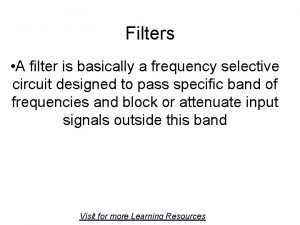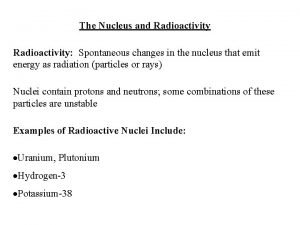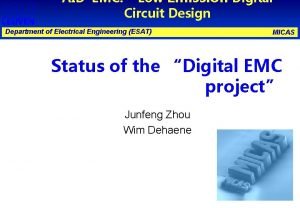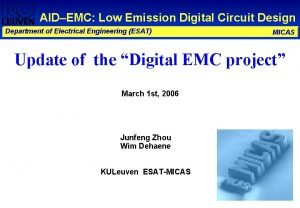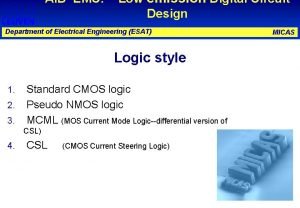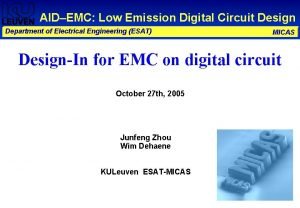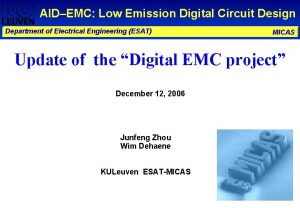AIDEMC Low Emission Digital Circuit Design Department of















- Slides: 15

AID–EMC: Low Emission Digital Circuit Design Department of Electrical Engineering (ESAT) MICAS Update of the “Digital EMC project” May 9 th, 2006 Junfeng Zhou Wim Dehaene KULeuven ESAT-MICAS

Outline Department of Electrical Engineering (ESAT) 1. Theoretical analysis of the EMI regulator 2. Future work MICAS

Why we need small signal analysis Department of Electrical Engineering (ESAT) MICAS peaking H(s)-d. B Frequency

Current TF: small signal model Department of Electrical Engineering (ESAT) • • • z 1 – Gm/Caux z 2 – parasitic zero, high frequency p 1 – Pole at Vctrl: Gm/Caux p 2 – Pole at VVDD_input: gm/Ctank p 3 – pole caused by compensation path, high frequency MICAS

Current TF: pole-zero tracking Department of Electrical Engineering (ESAT) MICAS • z 1 cancel off the p 1 H(s)-d. B • Make the p 2 cut-off frequency • This zero is intrinsic for this feedback topology peaking sacrifices dynamic noise performance Options • Make p 2 dominant • Advanced compensation techniques needed z 1 p 2 Frequency

Current TF: pole-zero tracking Department of Electrical Engineering (ESAT) MICAS |H(s)|-d. B peaking z 1 Frequency p 1 p 2

Possible solution Department of Electrical Engineering (ESAT) • Key Idea : Achieving Stability Without Sacrificing Dynamic Supply Current Rejection • R-C compensation no miller effect now ! • RC added for moving the output pole high frequency, also for improvement of the dynamic di/dt rejection • Reduced Gm of OTA MICAS

Stability analysis Department of Electrical Engineering (ESAT) MICAS p 1 • p 1 – Pole at Vctrl: [rota. Caux]-1 • p 2 – Pole at VVDD_input: [(ro||rc)Ctank]-1 • z 1 – [raux. Caux]-1 z 1 p 2

Stability--Simulation results Department of Electrical Engineering (ESAT) MICAS Ctank: 100 p Iload: 25 u. A~72 m A Gm : 4 u. A/V RC: 1 K Ctank: 100 p Caux: 20 p F Raux: 100 K φ>72°

Current TF analysis Department of Electrical Engineering (ESAT) MICAS • p 1 – • p 2 – Rc makes p 1 and z 1 well separated • z 1 – • z 2 – high frequency

Current TF--Simulation results Department of Electrical Engineering (ESAT) MICAS Ctank: 100 p Iload: 20 u. A~72 m A -3 d. B 40 m. A 1. 265 m. A 40 u. A TF vs. ILoad 225 u. A 7. 113 m. A Gm : 4 u. A/V RC: 1 K Ctank: 100 p Caux: 20 p F Raux: 100 K AC behavior of the LOAD ?

Current TF--Simulation results Department of Electrical Engineering (ESAT) -3 d. B 40 p. F 120 p. F 80 p. F TF vs. Caux MICAS 0 p. F Ctank: 100 p Caux= 20 p. F~120 p. F Iload: 1. 256 m. A Gm : 4 u. A/V RC: 1 K Ctank: 100 p Raux: 100 K AC behavior of the LOAD ?

“ Impedance” information ? Department of Electrical Engineering (ESAT) MICAS impedance EMI Regulator Z VDD_input LDO/ Series Regulator V 3 v 3 impedance Z switching EMI regulator should be designed to make dynamic adjustment according to the impedance changes of the LOAD IC

Future work Department of Electrical Engineering (ESAT) MICAS 1. Measurement and characterization of EMI regulator , EMI(di/dt) characterization of different circuits as a function of gate count, clock frequency, … Improved structure of EMI regulator for better dynamic noise suppression, 2. Continue research on the Clock strategy ? Need discussion later

Questions Department of Electrical Engineering (ESAT) Thank you for your attention MICAS
 Ultra low emission burner
Ultra low emission burner Mid = (low + high) / 2
Mid = (low + high) / 2 Reflective communication style
Reflective communication style Low accuracy low precision
Low accuracy low precision Low voltage hazards
Low voltage hazards Selective filter
Selective filter Series circuit vs parallel circuit
Series circuit vs parallel circuit Two types of circuits
Two types of circuits Circuit construction kit
Circuit construction kit Series vs parallel
Series vs parallel Difference between complete and incomplete circuit
Difference between complete and incomplete circuit Voltage in parallel
Voltage in parallel Venn diagram of series and parallel circuit
Venn diagram of series and parallel circuit Blood circulation system diagram
Blood circulation system diagram Current in a parallel circuit
Current in a parallel circuit Radioactive examples
Radioactive examples





